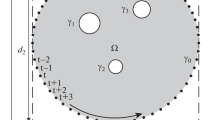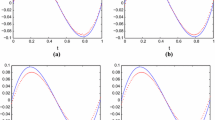ABSTRACT
New h-, p-, and hp-versions of the least-squares collocation method (LSCM) are proposed and implemented for solving the Dirichlet problem for a Poisson equation. Examples are considered of solving problems with singularities such as large gradients, fast growing rate of solution derivatives with increasing order of differentiation, discontinuities of second-order derivatives at angular points of the domain boundary, and solution oscillations with various frequencies for an infinite discontinuity point for derivatives of any order. The new versions of the method are based on a special selection of collocation points in the roots of Chebyshev polynomials of the first kind. The basis functions are defined as products of Chebyshev polynomials. The behavior of numerical solutions on a sequence of grids with an increasing degree of the approximating polynomial is analyzed by using exact analytical solutions. Formulas for the extension operation of transition from a coarse grid to a finer one on a multi-grid complex in the Fedorenko method are obtained.
Similar content being viewed by others
REFERENCES
Belyaev, V.A. and Shapeev, V.P., Solving the Dirichlet Problem for the Poisson Equation by the Least Squares Collocation Method with Given Discrete Boundary Domain, Vych. Tekhnol., 2018, vol. 23, no. 3, pp. 15–30.
Vorozhtsov, E.V. and Shapeev, V.P., On Combining the Techniques for Convergence Acceleration of Iteration Processes during the Numerical Solution of Navier–Stokes Equations, Vych. Met. Programm., 2017, vol. 18, no. 1, pp. 80–102.
Fedorenko, R.P., The Speed of Convergence of One Iterative Process, Zh. Vych. Mat. Mat. Fiz., 1964, vol. 4, no. 3, pp. 559–564.
Babuška, I. and Guo, B.Q., The h, p and h-p Version of the Finite Element Method; Basis Theory and Applications, Adv. Engin. Software, 1992, vol. 15, nos. 3/4, pp. 159–174.
Isaev, V.I., Shapeev, V.P., and Eremin, S.A., An Investigation of the Collocation and the Least Squares Method for Solution of Boundary Value Problems for the Navier–Stokes and Poisson Equations,Vych. Tekhnol., 2007, vol. 12, no. 3, pp. 53–70.
Isaev, V.I., Shapeev, V.P., and Idimeshev, S.V., High-Accuracy Versions of the Collocations and Least Squares Method for Numerical Solution of the Poisson Equation, Vych. Tekhnol., 2011, vol. 16, no. 1, pp. 85–93.
Sleptsov, A.G. and Shokin, Yu.I., An Adaptive Grid-Projection Method for Elliptic Problems, Zh. Vych. Mat. Mat. Fiz., 1997, vol. 37, no. 5, pp. 572–586.
Saad, Y., Numerical Methods for Large Eigenvalue Problems, Manchester Univ. Press, 1992.
Shapeev, V.P. and Shapeev, A.V., Solutions of the Elliptic Problems with Singularities Using Finite Difference Schemes with High Order of Approximation, Vych. Tekhnol., 2006, vol. 11, part 2. Special iss., pp. 84–91.
Abouali, M. and Castillo, J.E., Solving Poisson Equation with Robin Boundary Condition on a Curvilinear Mesh Using High Order Mimetic Discretization Methods, Math. Comput. Simul., 2017, vol. 139, pp. 23–36.
ACKNOWLEDGMENTS
The author would like to thank L.S. Bryndin and V.P. Shapeyev for their interest in this work and useful discussions.
Funding
This work was performed under the Fundamental Scientific Research Program of State Academies of Sciences for 2013–2020 (project no. AAA-A19-119051590004-5).
Author information
Authors and Affiliations
Corresponding author
Rights and permissions
About this article
Cite this article
Belyaev, V.A. Solving a Poisson Equation with Singularities by the Least-Squares Collocation Method. Numer. Analys. Appl. 13, 207–218 (2020). https://doi.org/10.1134/S1995423920030027
Received:
Revised:
Accepted:
Published:
Issue Date:
DOI: https://doi.org/10.1134/S1995423920030027




